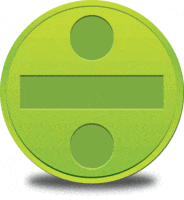Polynomial Division Worksheets
Polynomials are expressions that are composed of variables, coefficients, and constants. When we are dividing polynomials, we start by arranging the terms with the highest degree placed first (to the left) and the lower degrees placed in order behind them (to the right). When we begin this the dividend and divisor are placed in the same arrangement that they are for normal addition. We will explore a number of different ways to process these operations including by splitting the terms and factorization. It will take you some time to determine which method fits which scenario. Students can learn how to divide polynomials through the help of these worksheets and lessons.
Aligned Standard: HSA.APR.A.1
- Step-by-step Lesson- We start with a vertical problem. It's to start in this format, the orientation helps students identify the problem set.
- Polynomial Long Division Guided Lesson - A mix of vertical and horizontal format.
- Guided Lesson Explanation - We tried to keep it to a single printable page, but it was unreadable. Its two-pages.
- Horizontal Polynomial Division Worksheet 1 - Twelve practice problems in a horizontal orientation.
- Synthetic Polynomial Division Worksheet 2 - We use a solid strategy with students to help them note take as they solve problems.
- Polynomial Quotient Review 4-Pack - A page of synthetic problems followed by polynomials being divided by monomials.
- Answer Keys - These are for all the unlocked materials above.
Homework Sheets
We cover all formats and orientations for homework. The first problem is done for them.
- Homework 1 - Find the quotient. In most of the problems that are presented here it is straight forward.
- Homework 2 - There is a hidden simple method to solve these. The example problem will walk you through it.
- Homework 3 - Remember that the numerator is the top value of the fraction and the denominator is the bottom part. The problems here are setup up in long form and may require more space to work with. That is why there are less exercises on the worksheet.
Practice Worksheets
We complement the homework problems with these practice sheets.
- Practice 1 - The numerator goes first in the division method. Factoring may help you with a few of these problems, but it doesn't apply to all of them.
- Practice 2 - Divide the first term of the numerator by the first term of the denominator.
- Practice 3 - Then multiply the denominator by that value. That is another method you can use to flip the operation, if it makes it easier for you.
Math Skill Quizzes
Each quiz successively builds on the skill and challenges students.
- Quiz 1 - This is setup up as a simple vertical quotient. Great to test the most basic of skills for students who are having trouble with it.
- Quiz 2 - This is a huge step up from the first quiz. These are long form problems.
- Quiz 3 - Find the quotient using synthetic polynomial division. Use the back of the paper to show your work. There are 12 problems on this page that test all levels of the skill that we have learned.
Tips for Polynomial Division

A polynomial is a mathematical statement involving more than two algebraic expressions. Just like normal long division, when you are dividing polynomials, you need a strategy in order to be solved in a simplistic way. Polynomial division operations also need to use a different method or approach. If you're dividing a polynomial with another complicated polynomial, follow these tips to make it easy for you.
Start by reading the problem thoroughly. If you notice that the polynomial is being divided by a binomial, you can set it up in the standard way, just like you would do with a series of numbers. If the polynomials are both three terms or more, it is best to set it up using the long division method. Begin by drawing the dividend and divisor's space. Now multiply the first term with the divisor. After multiplying, subtract the result from the original number. Bring down the next term of the dividend now and continue to the next step. Now start the process all over again. Soon you will have a final quotient you will be required to subtract. Continue to the end. Deal with the remainders if you are required to. To record a remainder just place it by the bottom of the polynomial. Report your results now.
If you are the one who dreads dealing with polynomial division and fear long polynomial terms, you need to follow the above tips and make your life a whole lot easier.
When Will You Need This Skill in Real Life?
This is skill is highly directly applicable to many different forms of engineering and mechanics. When engineers or mechanics are trying to get an understanding of a solid whether it is physically in front of them or if it has been modelled on a computer they often work within the confines of the concept of volume. Depending on the shape of the object, there are often three measures that are taken into consideration of three-dimensional objects to determine the volume. When it is an object they cannot physically measure, they will often create polynomials to diagram these measures. If one of the measures needs to be predicted, often a quotient is taken somewhere along the way. When they must predict the movement and changes to the material, this is critical measure to be precise with. You will find that this skill is really helpful in calculus to simplify equations before you start to manipulate them. In addition to equations, it can also help you make functions more stable. In computer programming this skill is often used to simplify algorithmic rules to optimize a system or computer-based task. The more accurate the rule, the less processing power that is required to run it thereby lessen the load.